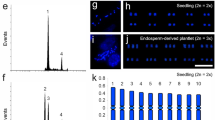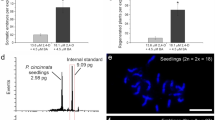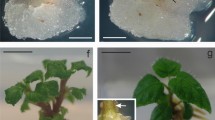Abstract
Triploid plants represent an important resource for the breeding of fruit and ornamental plants. Here, we report a facile and robust system for regenerating passion fruit triploid plants (Passiflora cincinnata Mast.) through in vitro endosperm culture. We describe the histological and biochemical aspects associated with the de novo shoot organogenesis. Endosperms were cultured on Murashige and Skoog medium supplemented with 1.5, 2.0, and 3.0 mg L−1 of 6-benzyladenine or thidiazuron, while a cytokinin-free medium was used as control. The highest percentage of organogenic calli (56%) was estimated at 1.7 mg L−1 6-benzyladenine, whereas the highest average number of shoots (24.85) per explant was estimated at 1.6 mg L−1 6-benzyladenine. Flow cytometry and chromosomal analysis confirmed that endosperm-derived plants were triploid, with a chromosome count of 27 (2n = 3x = 27) as well as a DNA amount similar to that of endosperm and 1.5 times greater than in diploid counterparts (2n = 2x = 18). The regeneration of adventitious shoots was evident 30 days after culture and occurred from the reprogramming of edge cells of the endosperm. During this process, lipids and proteins were quickly mobilized in the early stages of shoot organogenesis, whereas carbohydrates were synthesized throughout the development of adventitious shoots. This observation illustrates the mobilization dynamics of endosperm reserves during de novo shoot organogenesis in P. cincinnata.
Key message
Adventitious shoots induced by reprogramming of the outer cell layers of the endosperm generate true-to-type triploid passion fruit plants.





Similar content being viewed by others
References
Alexandre RS, Lopes JC, Tiradentes AT, Bruckner CH, Otoni WC (2013) Metodologia de minienxertia em maracujazeiros. Rev Bras Frut 35:329–332. https://doi.org/10.1590/S0100-29452013000100040
Antoniazzi CA, Faria RB, Carvalho PP, Mikovski AI, Carvalho IF, Matos EM, Reis AC, Viccini LF, Paim Pinto DL, Rocha DI, Otoni WC, Silva ML (2018) In vitro regeneration of triploid plants from mature endosperm culture of commercial passionfruit (Passiflora edulis Sims). Sci Hortic 238:408–441. https://doi.org/10.1016/j.scienta.2018.05.001
AOAC (1990) Official methods of analysis of the association of official analytical chemists. In: Horwitz W (ed) Method 989.05, 15th edn. Association of Official Analytical Chemists, Arlington
Atta R, Laurens L, Boucheron-Dubuisson E, Guivarch A, Carnero E, Giraudat-Pautot V, Rech P, Chriqui D (2009) Pluripotency of Arabidopsis xylem pericycle underlies shoot regeneration from root and hypocotyl explants grown in vitro. Plant J 57:626–644. https://doi.org/10.1111/j.1365-313X.2008.03715.x
Bernacci LC, Meletti LMM, Scott MDS, Passos IRS, Junqueira NTV (2005) Espécies de maracujá: caracterização e conservação da biodiversidade. In: Faleiro FG, Junqueira NTV, Braga MF (eds) Maracujá: germoplasma e melhoramento genético. EMBRAPA Cerrados, Planaltina, pp 559–586
Bewley D, Bradford KJ, Hilhorst HWM, Nonogaki H (2013) Seeds—physiology of development, germination and dormancy, vol 3. Springer, New York
Bharadwaj DN (2015) Polyploidy in crop improvement and evolution. In: Bahadur B (ed) Plant biology and biotechnology: plant diversity organization, function and improvement, vol 1. Springer, New York, pp 619–637
Bradford MM (1976) A rapid and sensitive method for the quantitation of microgram quantities of protein utilizing the principle of protein-dye binding. Anal Biochem 72:248–254
Cailleau A, Cheptou PO, Lenormand T (2010) Ploidy and the evolution of endosperm of flowering plants. Genetics 184:439–453. https://doi.org/10.1534/genetics.109.110833
Cangahuala-Inocente GC, Silveira V, Caprestano CA, Floh EIS, Guerra MP (2014) Dynamics of physiological and biochemical changes during somatic embryogenesis of Acca sellowiana. In Vitro Cell Dev Biol Plant 50:166–175. https://doi.org/10.1007/s11627-013-9563-3
Carvalho CR, Saraiva LS (1993) A new heterochromatin banding pattern revealed by modified HKG banding technique in maize chromosomes. Heredity 70:515–519
Chaturvedi R, Razdan MK, Bhojwani SS (2003) An efficient protocol for the production of triploid plants from endosperm callus of neem Azadirachta indica A. Juss. J Plant Physiol 160:557–564. https://doi.org/10.1078/0176-1617-00884
Chen J, Tang X, Ma X, Zhao Q, Dong Z (2014) Generation of a new polyploid grape cultivar by using hybrid seeds induced with colchicine. Acta Hortic 1046:251–258
Corner EJH (1976) The seeds of dicotyledons, vol 1. Cambridge University Press, Cambridge
Dias LLC, Santa-Catarina C, Ribeiro DM, Barros RS, Floh EIS, Otoni WC (2009) Ethylene and polyamine production patterns during in vitro shoot organogenesis of two passion fruit species as affected by polyamines and their inhibitor. Plant Cell Tissue Organ Cult 99:199–208. https://doi.org/10.1007/s11240-009-9594-y
Dubois M, Gilles KA, Hamilton JK, Rebers PT, Smith F (1956) Colorimetric method for determination of sugars and related substances. Anal Chem 28:350–356
Faleiro FG, Junqueira N, Junghans T, Jesus O, Miranda D, Otoni WC (2019) Advances in passion fruit (Passiflora spp.) propagation. Rev Brasil Frutic 41:155. https://doi.org/10.1590/0100-29452019155
Faria RB, Carvalho IF, Rossi AB, Matos EM, Rocha DI, Paim Pinto DL, Otoni WC, Silva ML (2018) High responsiveness in de novo shoot organogenesis induction of Passiflora cristalina (Passifloraceae), a wild Amazonian passion fruit species. In Vitro Cell Dev Biol Plant 54:166–174. https://doi.org/10.1007/s11627017-9881y
Fernie AR, Roscher A, Ratcliffe RG, Kruger NJ (2001) Fructose 2,6-bisphosphate activates pyrophosphate: Fructose-6-phosphate 1-phosphotransferase and increases triose phosphate to hexose phosphate cycling heterotrophic cells. Planta 212:250–263. https://doi.org/10.1007/s004250000386
Ferreira DF (2011) Sisvar: a computer statistical analysis system. Cien Agrotec 35:1039–1042. https://doi.org/10.1590/S1413-70542011000600001
Galbraith DW, Harkins KR, Maddon JM, Ayres NM, Sharma DP, Firoozabady E (1983) Rapid flow cytometric analysis of the cell-cycle in intact plant tissues. Science 220:1049–1051. https://doi.org/10.1126/science.220.4601.1049
Góralski G, Popielarska M, Slesak H, Siwinska D, Batycka M (2005) Organogenesis in endosperm of Actinidia deliciosa cv. Hayward cultured in vitro. Acta Biol Crac Ser Bot 47:121–128
Graham IA (2008) Seed storage oil mobilization. Ann Rev Plant Biol 59:115–142. https://doi.org/10.1146/annurev.arplant.59.032607.092938
Gui Y, Hong SKS, Skirvin RM (1993) Fruit and vegetative characteristics of endosperm-derived kiwifruit (Actinidia chinensis F.) plant. Euphytica 71:57–62
Guzzo F, Ceoldo S, Andreetta F, Levi M (2004) In vitro culture from mature seeds of Passiflora species. Sci Agric 61:108–113. https://doi.org/10.1590/S0103-90162004000100018
Hoshino Y, Miyashita T, Thomas TD (2011) In vitro culture of endosperm and its application in plant breeding: approaches to polyploidy breeding. Sci Hortic 130:1–8
Ikeuchi M, Ogawa Y, Iwase A, Sugimoto K (2016) Plant regeneration: cellular origins and molecular mechanisms. Development 143:1442–1451. https://doi.org/10.1242/dev.134668
Johri BM, Bhojwani SS (1965) Growth responses of mature endosperm in cultures. Nature 208:1345–1347
Jones MPA, Yiz MSJ, Saxena PK (2007) Thidiazuron-induced regeneration of Echinacea purpurea L.: micropropagation in solid and liquid culture systems. Plant Cell Rep 26:13–19. https://doi.org/10.1007/s11240-009-9581-3
Kumar A, Gupta N (2015) Applications of triploids in agriculture. In: Bahadur B, Venkat Rajam M, Sahijram L, Krishnamurthy K (eds) Plant biology and biotechnology. Springer, New Delhi, pp 385–396
Kurczyńska EU, Gaj MD, Ujczak A, Mazur E (2007) Histological analysisbof direct somatic embryogenesis in Arabidopsis thaliana (L.) Heynh. Planta 226:619–628. https://doi.org/10.1007/s00425-007-0510-6
Kurczyńska EU, Potocka I, Dobrowolska I, Kulinska-Lukaszek K, Sala K, Wrobel J (2012) Cellular markers for somatic embryogenesis. In: Sato K-I (ed) Embryogenesis. InTech, Rijeka, pp 307–332
Lombardi SP, Passos IRS, Nogueira MCS, Appezzato-da-Glória B (2007) In vitro shoot regeneration from roots and leaf discs of Passiflora cincinnata Mast, Brazil. Arch Biol Technol 50:239–247. https://doi.org/10.1590/S1516-89132007000200009
Loureiro J, Rodriguez E, Doležel J, Santos C (2007) Two new nuclear isolation buffers for plant DNA flow cytometry: atest with 37 species. Ann Bot 100:875–888. https://doi.org/10.1093/aob/mcm152
Martin AB, Cuadrado Y, Guerra H, Gallego P, Hita O, Martin L, Dorado A, Villalobos N (2000) Differences in the contents of total sugars, starch and sucrose in embryogenesis and non-embryogenic calli from Medicago arborea L. Plant Sci 154:143–151. https://doi.org/10.1016/s0168-9452(99)00251-4
Mikovski AI, Silva NT, Souza CS, Machado MD, Otoni WC, Rocha DI, Silva ML (2019) Tissue culture and biotechnological techniques applied to passion fruit with ornamental potential: an overview. Ornam Hortic 25:189–199
Miyashita T, Ohashi T, Shibata F, Araki H, Hoshino H (2009) Plant regeneration with maintenance of the endosperm ploidy level by endosperm culture in Lonicera caerulea var. emphyllocalyx. Plant Cell Tissue Organ Cult 98:291–301. https://doi.org/10.1007/s11240-009-9562-6
Mohamed ME, Hicks RGT, Blakesley D (1996) Shoot regeneration from mature endosperm of Passiflora foetida. Plant Cell Tissue Organ Cult 46:161–164. https://doi.org/10.1007/BF00034851
Muñoz-Concha D (2016) Culture of triploid tissue from the endosperm of endangered Chilean tree species Gomortega keule. J Hortic Sci Biotech 91:79–86. https://doi.org/10.1080/14620316.2015.1110995
Murashige T, Skoog F (1962) A revised medium for rapid growth and bio assays with tobacco tissue cultures. Physiol Plant 15:473–497
O’Brien TP, McCully ME (1981) The study of plant structure: principles and selected methods. Termarcarphy Pty, Melbourne
Oliveira EJ, Koehler AD, Rocha DI, Vieira LM, Pinheiro MVM, Matos EM, Cruz ACF, Silva TCR, Tanaka FAO, Nogueira FTS, Otoni WC (2017) Morpho-histological, histochemical, and molecular evidences related to cellular reprogramming during somatic embryogenesis of the model grass Brachypodium distachyon. Protoplasma 254:2017–2024. https://doi.org/10.1007/s00709-017-1089-9
Otoni WC, Paim Pinto DL, Rocha DI, Vieira LM, Dias LLC, Silva ML, Silva CV, Lani ERG, Silva LC, Tanaka FA (2013) Organogenesis and somatic embryogenesis in passionfruit (Passifloras sp.). In: Aslam J, Srivastava OS, Sharma MP (eds) Somatic embryogenesis and gene expression. Narosa Publishing House, New Delhi, pp 1–17
Paim Pinto DL, Silva ML, Barros BA, Viccini LF, Campos JMS, Otoni WC (2010) Ploidy stability of somatic embryogenesis-derived Passiflora cincinnata Mast. plants as assessed by flow cytometry. Plant Cell Tissue Organ Cult 103:71–79. https://doi.org/10.1007/s11240-010-9756-y
Popielarska M, Ślesak H, Goralski G (2006) Histological and studies on organogenesis in endosperm-derived callus of kiwifruit (Actinidia deliciosa cv. Hayward). Acta Biol Crac Ser Bot 48:97–104
Popielarska-Konieczna M, Kleszcz I (2015) Preliminary studies on plants regenerated from endosperm-derived callus of kiwifruit (Actinidia deliciosa var. deliciosa). Mod Phyt 7:55–57. https://doi.org/10.5281/zenodo.160362
Rangan P (2020) Endosperm variability: from endoreduplication within a seed to higher ploidy across species, and its competence. Seed Sci Res 1:13. https://doi.org/10.1017/S0960258520000148
Rocha DI, Vieira LM, Tanaka FAO, Silva LC, Otoni WC (2012) Somatic embryogenesis of a wild passion fruit species Passiflora cincinnata Masters: histocytological and histochemical evidences. Protoplasma 249:747–758. https://doi.org/10.1007/s00709-011-0318-x
Rocha LS, Ribeiro RCF, Xavier AA, Silva FJ, Bruckner CH (2013) Reação de genótipos de maracujazeiro a Meloidogyne incognita raça 3 e Meloidogyne javanica. Rev Bras Frutic 35:1017–1024. https://doi.org/10.1590/S0100-29452013000400012
Rocha DI, Monte-Bello CC, Dornelas MC (2015) Alternative induction of de novo shoot organogenesis or somatic embryogenesis from in vitro cultures of mature zygotic embryos of passion fruit (Passiflora edulis Sims) is modulated by the ratio between auxin and cytokinin in the medium. Plant Cell Tissue Organ Cult 120:1087–1098. https://doi.org/10.1007/s00709-015-0837-y
Rocha DI, Monte-Bello CC, Aizza LCB, Dornelas MC (2016a) A passion fruit putative ortholog of the somatic embryogenesis Receptor Kinase1 gene is expressed throughout the in vitro de novo shoot organogenesis developmental program. Plant Cell Tissue Organ Cult 125:1–11. https://doi.org/10.1186/s12870-018-1337-y
Rocha DI, Pinto DLP, Vieira LM, Tanaka FAO, Dornelas MC, Otoni WC (2016b) Cellular and molecular changes associated with competence acquisition during passion fruit somatic embryogenesis: ultrastructural characterization and analysis of SERK gene expression. Protoplasma 253:595–609. https://doi.org/10.1007/s00709-015-0837-y
Rocha DI, Batista DS, Faleiro FG, Rogalski M, Ribeiro LM, Mercadante-Simões MO, Yockteng R, Silva ML, Soares WS, Pinheiro MVM, Pacheco TG, Lopes AS, Viccini LF, Otoni WC (2020) Passiflora spp. Passionfruit. In: Litz RE, Pliego-Alfaro F, Hormaza JI (eds) Biotechnology of fruit and nut crops (Agriculture), vol 1, 2nd edn. CABI, Boston, pp 381–408
Schindelin J, Arganda-Carreras I, Frise E, Kaynig V, Longair M, PietzschT PS, Rueden C, Saalfeld S, Schmid B, Tinevez J-Y, White DJ, Hartenstein V, Eliceiri K, Tomancak P, Cardona A (2012) Fiji: an open-source platform for biological-image analysis. Nat Methods 9:676–682. https://doi.org/10.1038/nmeth.2019
Silva ML, Paim Pinto DL, Guerra MP, Floh EIS, Bruckner CH, Otoni WC (2009) novel regeneration system for wild passion fruits species (Passiflora cincinnata Mast.) based on somatic embryogenesis from mature zygotic embryos. Plant Cell Tissue Organ Cult 99:47–54. https://doi.org/10.1007/s11240-009-9574-2
Silva CV, Oliveira LS, Loriato VAP, Silva LC, Campos JMS, Viccini LF, Oliveira EJ, Otoni WC (2011) Organogenesis from root explants of commercial populations of Passiflora edulis Sims and a wild passionfruit species, P. cincinnata Masters. Plant Cell Tissue Organ Cult 107:407–416. https://doi.org/10.1007/s11240-011-9991-x
Silva GM, Cruz AC, Otoni WC, Pereira TN, Rocha DI, Silva ML (2015) Histochemical evaluation of induction of somatic embryogenesis in Passiflora edulis Sims (Passifloraceae). In Vitro Cell Dev Biol Plant 51:539–454. https://doi.org/10.1007/s11627-015-9699-4
Silva-Cardoso IMA, Meira FS, Gomes ACMM, Scherwinski-Pereira JE (2020) Histology, histochemistry and ultrastructure of pre-embryogenic cells determined for direct somatic embryogenesis in the palm tree Syagrus oleracea. Physiol Plant 168:845–875. https://doi.org/10.1111/ppl.13026
Su YH, Liu YB, Bai B, Zhang XS (2015) Establishment of embryonic shoot-root axis is involved in auxin and cytokinin response during Arabidopsis somatic embryogenesis. Front Plant Sci 14:792. https://doi.org/10.3389/fpls.2014.00792
Sugiyama SI (2005) Polyploidy and cellular mechanisms changing leaf size: comparison of diploid and autotetraploid populations in two species of Lolium. Ann Bot 96:931–938. https://doi.org/10.1093/aob/mci245
Sun DQ, Lu XH, Liang GL, Guo OG, Mo YW, Xie JH (2011) Production of triploid plants of papaya by endosperm culture. Plant Cell Tissue Organ Cult 104:23–29. https://doi.org/10.1007/s11240-010-9795-4
Thomas TD, Chaturvedi R (2008) Endosperm culture: a novel method for triploid plant production. Plant Cell Tissue Organ Cult 93:1–14. https://doi.org/10.1007/s11240-008-9336-6
Thomas TD, Bhatnagar AK, Bhojwani SS (2000) Production of triploid plants of mulberry (Morus alba L.) by endosperm culture. Plant Cell Rep 19:395–399. https://doi.org/10.1007/s002990050746
Tian L, Ke Y, Gan S, Chen Y, Chen Y, Yang Z, Wang X (2012) Triploid plant regeneration from mature endosperms of Sapium sebiferum. Plant Growth Regul 68:319–324. https://doi.org/10.1007/s10725-012-9720-4
Tiku AR, Razdan MK, Raina SN (2014) Production of triploid plants from endosperm cultures of Phlox drummondii. Biol Plant 58:153–158. https://doi.org/10.1007/s10535-013-0372-7
Tozzi HH, Takaki M (2011) Histochemical analysis of seed reserve mobilization in Passiflora edulis Sims flavicarpa O. Deg. (yellow passion fruit) during germination. Braz J Biol 71:701–708. https://doi.org/10.1590/S1519-69842011000400015
Verdeil JL, Alemanno L, Niemenak N, Trambarger TJ (2007) Pluripotent versus totipotent plant stem cells: dependence versus autonomy? Trends Plant Sci 12:245–252. https://doi.org/10.1016/j.tplants.2007.04.002
Vieira LM, Silva PO, Fernandes AM, Rocha DI, Otoni WC (2018) Protocol for somatic embryogenesis in Passiflora cincinnata Mast. (Passifloraceae). In: Jain MS, Gupta P (eds) Stepwise protocols for somatic embryogenesis of woody plants, 2nd edn. Springer, Cham, pp 253–265
Wang X, Nolan KE, Irwanto RR, Sheahan MB, Rose RJ (2011) Ontogeny of embryogenic callus in Medicago truncatula: the fate of the pluripotent and totipotent stem cells. Ann Bot 107:599–609. https://doi.org/10.1093/aob/mcq269
Wang X, Cheng ZM, Zhi S, Xu F (2016) Breeding Triploid Plants: A Review. Czech J Gen Plant Breed 52:41–54
Yumbla-Orbes M, Rocha DI, Matos EM, Koehler AD, Pinheiro MVM, Batista DS, Freitas DMS, Cruz ACF, Barbosa JG, Vicinni LF, Otoni WC (2020) Somatic embryogenesis induced from vascular tissues in leaf explants of Lisianthus (Eustoma grandiflorum (Raf.) Shinn) generates true-to-type diploid plants. Vegetos 33:135–144. https://doi.org/10.1007/s42535-019-00091-8
Acknowledgements
This work was supported by “Fundação de Amparo à Pesquisa do Estado de Mato Grosso” (FAPEMAT) (Cuiabá, MT); Coordenação de Aperfeiçoamento de Pessoal de Nível Superior—Brazil (CAPES)—Finance Code 001; and Conselho Nacional de Desenvolvimento Científico e Tecnológico (CNPq) (420913/2018-1). We also thank the CNPq for granting a scholarship to MM (DCR-314905/2018-9). We would like to thank Editage (www.editage.com) for English language editing.
Funding
This work was supported by “Fundação de Amparo à Pesquisa do Estado de Mato Grosso” (FAPEMAT) (Cuiabá, MT), Coordenação de Aperfeiçoamento de Pessoal de Nível Superior—Brazil (CAPES)—Finance Code 001, and Conselho Nacional de Desenvolvimento Científico e Tecnológico (CNPq) (420913/2018-1).
Author information
Authors and Affiliations
Contributions
NTS established organogenic cultures and wrote the paper; LASS assisted with histological evaluations; MM performed biochemical analyses and revised the paper; ACR and EMM carried out the chromosome count and flow cytometry analyses; IFC designed the research and revised the paper; WCO and LFV revised the paper; DIR and MLS designed the research and wrote the paper.
Corresponding author
Ethics declarations
Conflict of interest
The authors declare that they have no conflicts of interest.
Consent for publication
All co-authors listed have approved the final version of the manuscript.
Additional information
Communicated by Sergio J. Ochatt.
Publisher's Note
Springer Nature remains neutral with regard to jurisdictional claims in published maps and institutional affiliations.
Rights and permissions
About this article
Cite this article
da Silva, N.T., Silva, L.A.S., Reis, A.C. et al. Endosperm culture: a facile and efficient biotechnological tool to generate passion fruit (Passiflora cincinnata Mast.) triploid plants. Plant Cell Tiss Organ Cult 142, 613–624 (2020). https://doi.org/10.1007/s11240-020-01887-2
Received:
Accepted:
Published:
Issue Date:
DOI: https://doi.org/10.1007/s11240-020-01887-2




